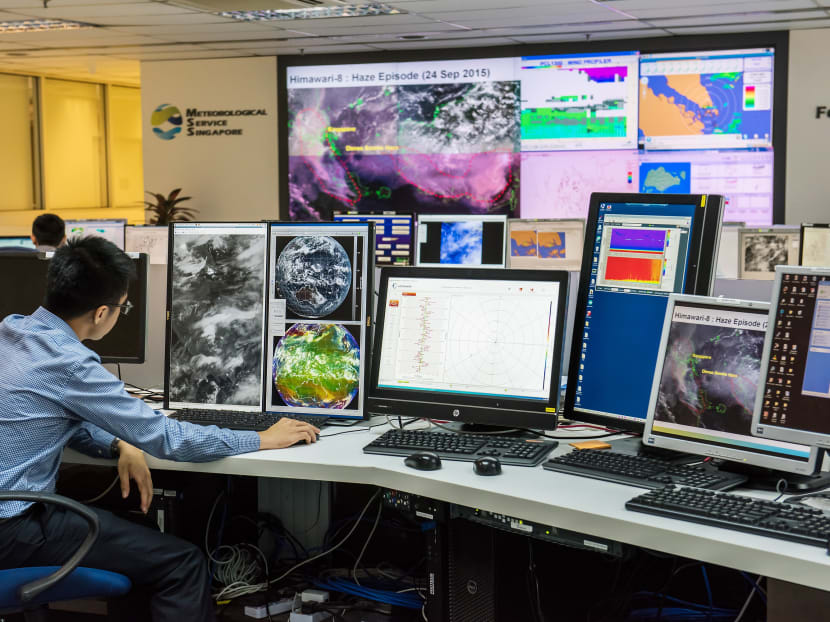Haze less likely as more rain seen in Q4, says Masagos
SINGAPORE — With more rain forecast for the latter part of 2016, the risk of haze blanketing the Republic could be lower this year, as forest fires will likely be put out faster, Environment and Water Resources Minister Masagos Zulkifli said on Monday (June 27).

Meteorologist Wong Song Han, 27, uses the Himawari-8 satellite and LIDAR system for monitoring weather and the haze. Photo: Nuria Ling/TODAY
SINGAPORE — With more rain forecast for the latter part of 2016, the risk of haze blanketing the Republic could be lower this year, as forest fires will likely be put out faster, Environment and Water Resources Minister Masagos Zulkifli said on Monday (June 27).
Speaking to reporters during a visit to the Meteorological Service Singapore’s (MSS) headquarters at Changi Airport Terminal 2, Mr Masagos said more rain was predicted towards the last quarter of the year. “Therefore, we hope that with more rain, there will be less haze episodes that come to us,” Mr Masagos said.
But he stressed that the Government could not be sure of this, given the unpredictable nature of the weather. There is the possibility of dry spells taking its toll over extended periods, and forests, particularly peatland, being set on fire. This may result in the Republic being besieged by haze.
Responding to TODAY’s queries, the National Environment Agency (NEA) said the strong El Nino event that triggered a protracted dry spell in the second half of last year has ended. The El Nino phenomenon is the warm phase of a temperature cycle in the tropical central and eastern Pacific Ocean.
While neutral conditions are prevailing over the region now, the NEA said the La Nina, which causes higher-than-normal rainfall, could develop in the third quarter of the year, based on model outlooks from international climate centres.
And with rainfall expected to be “normal to above normal” from June to September, weather conditions are forecast to be less conducive to hot spot activities than they were last year.
“However, as there could still be extended periods of drier weather, escalation of hot spot activities can occur, which may lead to transboundary haze, and Singapore could be affected if the winds blow the haze towards Singapore,” the NEA said.
Earlier in the day, Mr Masagos was briefed on the MSS’ new capabilities and technologies that support the national weather forecaster’s monitoring of the weather and haze.
Among them is imagery from the Himawari-8 geostationary meteorological satellite. The satellite provides more frequent updates, higher spatial resolution and more spectral bands than its predecessor, the MTSAT-2 satellite.
The Himawari-8, operated by the Japan Meteorological Agency, provides updates every 10 minutes, compared with hourly updates by the MTSAT-2, which stopped direct transmission last December. Its higher spatial resolution also means improved visible bands of between 0.5km and 1km compared with the MTSAT-2’s 1km, which means sharper details in satellite images.
In May, the MSS also installed an aerosol Light Detection and Ranging (Lidar) system on Jurong Island and a wind Lidar system in the south of Singapore.
Depending on atmospheric conditions, the aerosol Lidar can, among other things, measure the vertical extent of particulate matter to heights of about 12km. It can also offer an indication of upper-level transboundary haze wafting into the Republic.
The wind Lidar, which can measure the vertical profile of wind speed and direction up to about 12km above ground level, will complement the MSS’ existing wind profiler. This will improve the real-time tracking of upper-level winds, which affect the movement of weather systems and haze over Singapore.
The authorities are still studying the new capabilities, Mr Masagos said. “But for the future, I’m quite sure these can be used to give even finer forecasts for the hour … (which will be) more useful and predictable for the public.” ADDITIONAL REPORTING BY NEO CHAI CHIN








